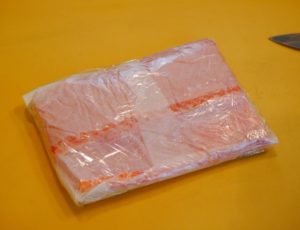

How to Thaw Fish with Culinary Director Grace Parisi And finally, if you aren’t going to cook or sear the fish and instead plan to eat it raw, you risk exposing it to bacteria normally found in a household refrigerator, like Listeria. Second, fish starts dehydrating in the refrigerator once the package is open, so we advise waiting to thaw your fish until you plan to eat it. For one thing, your fridge may smell like fish - even if you transfer it to a sealed container.


There are some things you should prepare for, however. To completely eliminate risk, we recommend you puncture the package to introduce oxygen and allow the fish to thaw in your refrigerator overnight. Leaving fish in the fridge for too long without accounting for temperature shifts can produce a time and temperature combination that might be deadly if you aren’t careful. And if your household is anything like mine, as soon as your food hits the back of the refrigerator it falls into a black hole until you clean it out or investigate the unpleasant odor. That’s quite a range for a normal size refrigerator.Ĭommon practices, like leaving the fridge door open or removing frozen foods, can increase the internal temperature of the fridge. At the same time, the back of the lower shelves held at 34.4 F. The top shelf held at about 42.6 F, but jumped to 50 F within ten seconds of being opened. Out of curiosity, I checked the temperature of my 15-year-old refrigerator with my calibrated, accurate digital thermometer. What is the concern if it takes so long for this to happen at common refrigerated temperatures?įridge temperatures are sensitive and can fluctuate widely, meaning it’s not always easy to predict the conditions we store our food in - or assume that they aren’t fertile ground for bacteria. Even between 42℉ and 50℉ it would take two days to grow and produce toxin. However, the product would have to be between 37.9℉ and 41℉ for seven days for the bacteria to accomplish this. bot, and the most resilient types can grow and produce toxins at temperatures as low as 37.9℉. Why would someone recommend opening the pouch to thaw if you keep the fish cold throughout the process of thawing? Vacuum seals ensure a high caliber of fish for consumers, and with the proper precautions, you don't have to sacrifice quality for safety. And of course, vacuum seals keep your freezer (and home) from smelling like fish. Vacuum packages also prevent the healthy fats and oils in fish from oxidizing, which can leave fish tasting rancid. Even in a freezer, that water will evaporate if unsealed and cause freezer burn. For one thing, there’s a lot of water in the flesh of fish. Vacuum-sealing the fish helps to maintain quality in a couple ways. The moment a fish takes its last breath, the quality will degrade if not protected. Why would anyone vacuum-package fish if there is such a great risk?įish is one of the most delicate meats to store and prepare. Botulism toxin, while scary, is easily destroyed by heating your food to at least 185℉ for five minutes. To eliminate risk, avoid thawing your fish in an intact vacuum package. The short answer: botulism develops only at specific temperatures and if there is little to no oxygen present. bot only causes illness if it can produce the botulism toxin, and we’re here to tell you how to keep that from happening. bot either because its habitat generates the bacteria, or because of exposure somewhere between where the animal dies and your dinner plate. Packaged fish is commonly known to contain C. Here’s what to know.įish is to Clostridium Botulinum (C. For that reason, most government agencies, industry organizations, and food safety websites urge you to puncture the package to release the vacuum. Yes, you absolutely can - if you do not thaw your fish properly. Can you really get sick from thawing your vacuum-packaged fish in a vacuum-sealed package? *This article cannot be substituted for safety advice and we encourage you to refer to USDA recommended guidelines.


 0 kommentar(er)
0 kommentar(er)
